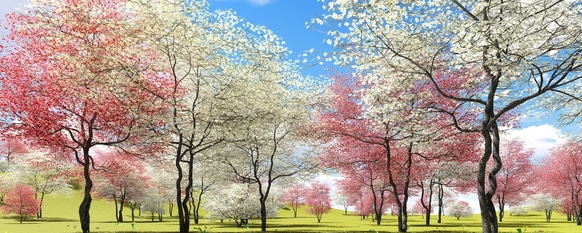Dogwoods thrill your landscape with a blanket of color and interest year-round. They add a particular magnificence and beauty in whatever yard they grace. When it comes to dogwoods, what’s not to love?
If you want to learn all about dogwood trees, then you’ve come to the right place. We cover everything from the basics to where to plant. There’s even a bit of information about some popular types.
Continue reading as we explain everything you’ll need to know for successfully growing a dogwood. Along the way, it will be easy to see why these are such popular beauties.
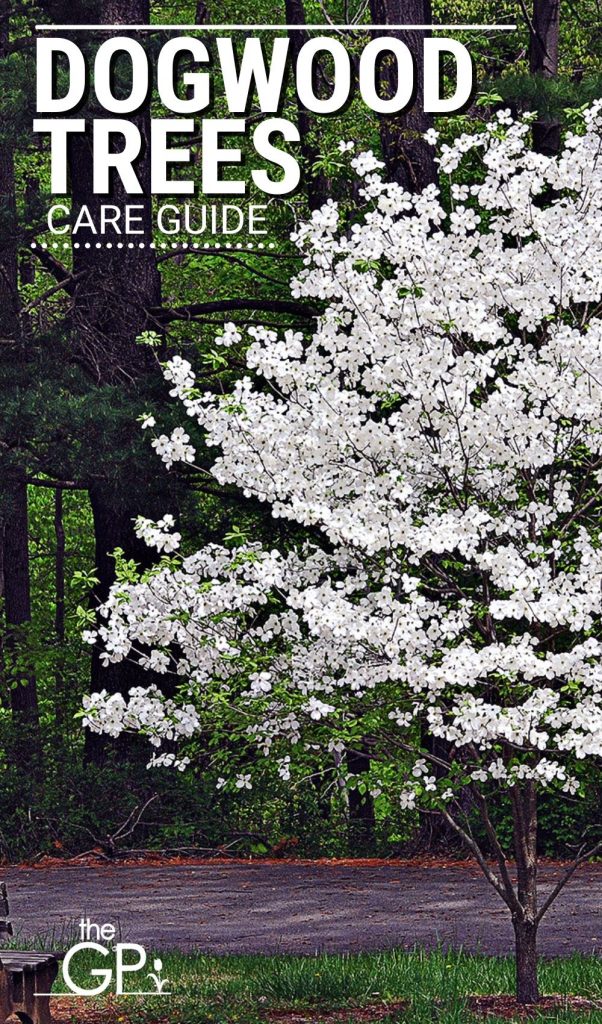
General Information
Dogwoods are members of the Cornaceae family and in the Genus Cornus, of which there are around 60 different species.
The United States can claim 11 native species of dogwood. In fact, it’s been a beloved tree going back to George Washington and Thomas Jefferson. Both men transplanted trees from the surrounding forest into their estates.
The vast majority of them are deciduous shrubs or trees. However, some woody types perform as evergreens.
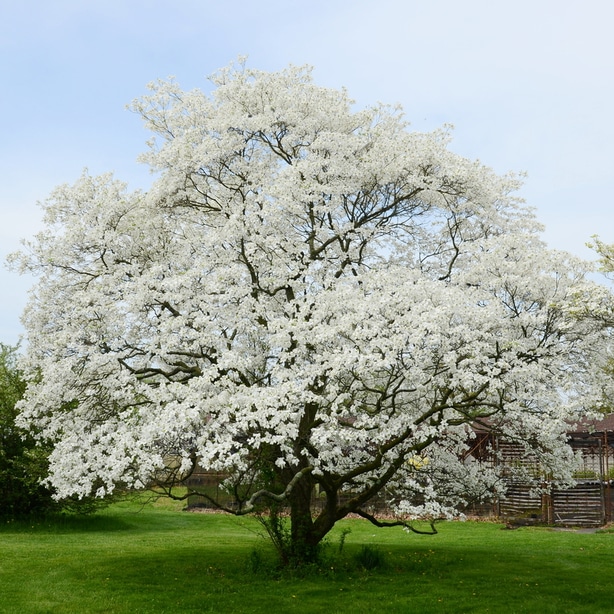
Flowering is just as varied. Some produce inconspicuous flowers, whereas others bloom with large, colorful bracts. All types start blooming in spring. The color you see is actually from the bracts, which are leaves right below the small center flower.
In fall, the spent flowers then develop into drupes containing one to two seeds. The drupes can be quite colorful. Drupes produced from plants in the subgenera Cornus are safe to eat. However, it’s thought that many varieties aren’t very tasty.
Varieties
Below are some of the more popular types and their characteristics. Make sure to keep reading below to find our care guide.
Kousa
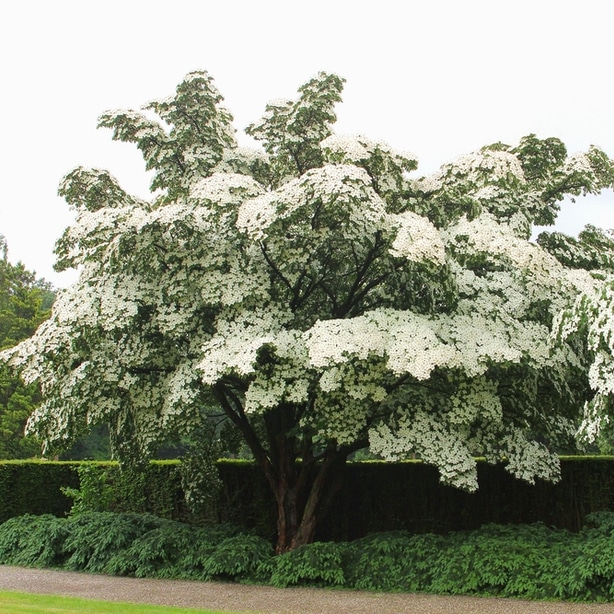
Kousa dogwood (Cornus kousa) are hardy growing in USDA zones 5 to 8. It forms into a small flowering tree that is deciduous. It also performs as a shrub with multiple branches. It typically grows 15 to 30 feet tall and wide.
While it is a sapling, it develops a vase-shape. However, as it matures, it develops a more rounded form.
The oval and pointed leaves grow 4 inches long and are dark green. Once fall arrives, the leaves change to brilliant colors of scarlet and purplish-red. The foliage drops in winter, which showcases its mottled bark that is a shade of gray and tan.
In spring, the showy flowers start blooming that are up to 5 inches across. The pink and white flowers are attractive against the green foliage. The blooms attract beneficial pollinators like butterflies.
Kousa is a variety that requires well-drained soil for good growth.
Red Osier
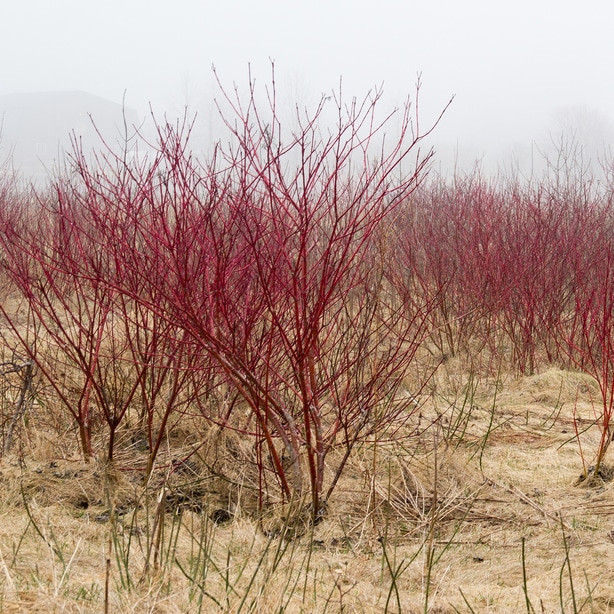
Red osier dogwood (Cornus sericea) is hardy in USDA zones 3 to 7. This large deciduous shrub is native to North America. Because of its appearance, it is also often called red twig.
Red osier develops into an upright but spreading shrub. It produces suckers, which, if left unpruned, allows it to grow up to 9 feet tall. It’s not unusual for the width to be larger than the plant’s height.
It produces 2- to 5-inch long green leaves attached to reddish stems. The foliage takes on hues of red and orange throughout the year. As autumn arrives, the fall foliage then changes to purple, giving the shrub a definite wow factor.
If that wasn’t enough, the reddish stems change to bright red. In fact, red osier dogwood gets its common name because its red stems resemble those of osier willows.
In late spring, clusters of small, white, fragrant flowers bloom. The shrub continues blooming off and on typically throughout summer.
Adding to the shrub’s interest are the whitish-blue drupes that form after the flowers fade in summer. Birds find the drupes quite tasty.
This variety grows well in a wide range of soil types, including soils that are wet and boggy. It naturally grows along river banks and streams, as well as swampy areas.
Flowering Dogwood
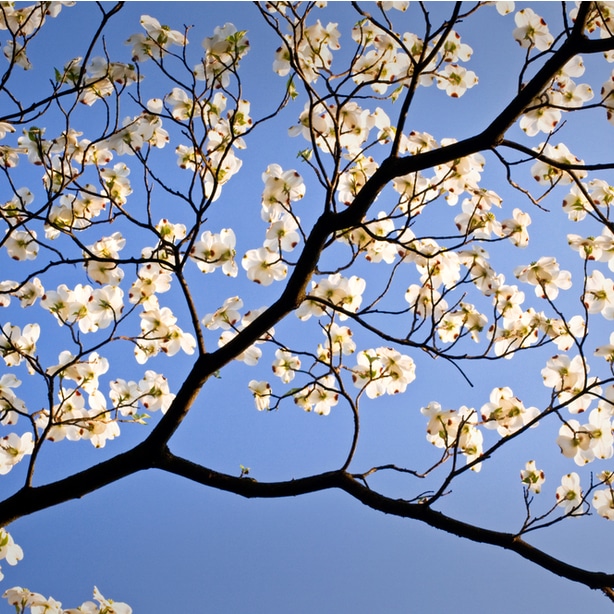
Although various varieties share the common name flowering dogwood, Cornus florida is one of the most popular. This variety holds the honor of being the state tree of Missouri. It’s native to Eastern North America.
Some might argue that Cornus florida is the prettiest of all America’s flowering trees. One look and you just might agree.
Cornus florida is hardy growing in USDA zones 5 to 9. It tolerates warmer conditions than many types do.
Flowering dogwoods form into small gracefully formed trees. They take on a pyramidal shape with a somewhat flat top with low hanging branches. Mature trees grow anywhere from 15 to 30 feet tall and wide.
The oval, 6-inch leaves are dark green and deciduous. The fall color won’t be a disappointment, as the foliage changes to fiery red.
In early spring, Cornus florida puts on its flower show. They produces 4-inch white flower bracts that fill the canopy with color.
If the colorful leaves and flowers weren’t enough, clusters of bright red berries form in summer after the flowers. Birds love the fruits.
Flowering dogwood has various cultivars, with some producing bright pink to red flowers. All types prefer well-drained soil conditions.
Dwarf Cornel

Also commonly called bunchberry, dwarf cornel (Cornus canadensis) is a cold-hardy tree that grows in USDA zones 2 to 6. It’s native to the northern portions of North America.
Plants perform as a shrubby ground cover, only growing about 9 inches tall and about a foot wide. It spreads by way of creeping rhizomes.
When picturing dwarf cornel, think of Cornus florida. It looks exactly like its bigger cousin, only in smaller dwarf form. The deciduous, glossy green foliage only grows around 1 inch long.
It displays brilliant hues of fall colors that are eye-catching. The green leaves change to rich red and purple colors, adding more interest to a cold landscape.
In late spring, the small, 1-inch white flower bracts form, filling the small shrub in white. The spent flowers then form into attractive clusters of small, bright red berries. The fruits are a tasty treat to birds and are edible for humans.
It grows best planted in well-drained soils.
This variety might be small in size but it’s big in color. It’s sure to add texture and interest season after season.
Mountain Dogwood
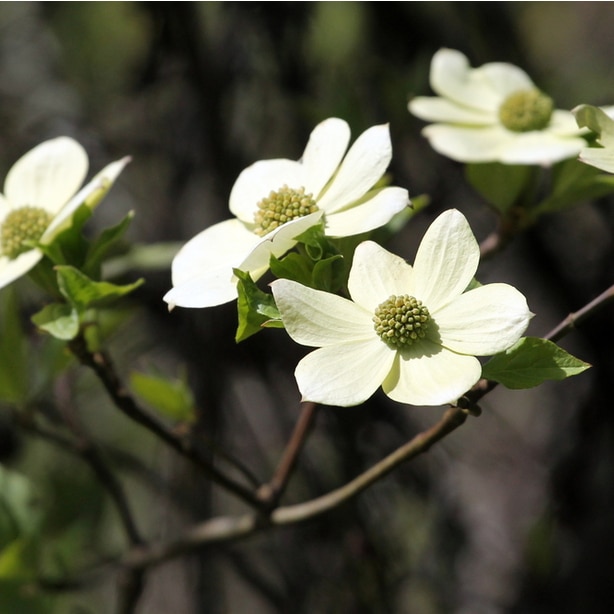
Mountain dogwood (Cornus nuttallii) goes by several common names. It’s also known as Pacific and Canadian dogwood. This western North American native is hardy growing in USDA zones 7 to 9 and also tolerates warmer conditions than many types.
It is the western version of the eastern native, flowering Cornus florida. One of the most significant differences between the two species is the number of flower bracts. Cornus florida contain four bracts, whereas the western species contains six.
Plants typically perform as small trees, although they can also grow as large shrubs. The tree grows anywhere from 15 feet to 40 feet tall and spreads 10 to 25 feet.
The branches form a horizontal and tiered structure. Dark green, 4.5-inch leaves cover the branches. As the seasons change, the leaves start changing colors taking on hues of yellow and orange. The tree offers a robust blast of fall color as the foliage finally turns red.
Mountain dogwood flowers in spring, producing large, 6-inch white bracts, which are quite showy. Once the blooms fade, small orange berries form, adding even more color.
For the best performance, grow in well-drained soil.
Pagoda
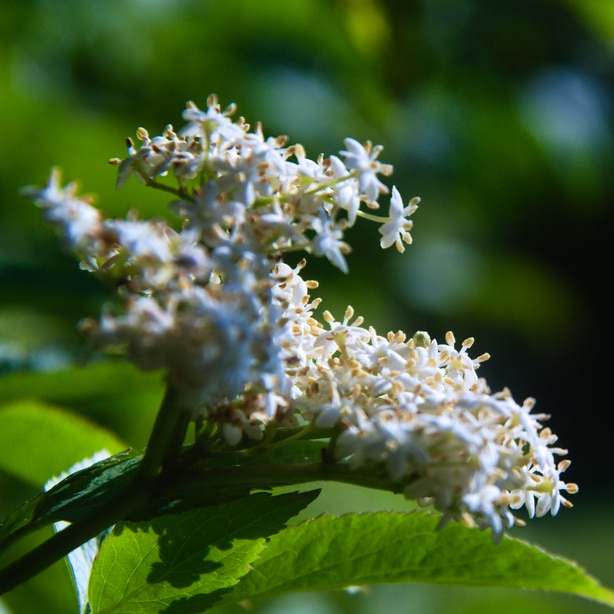
Pagoda dogwood (Cornus alternifolia) is native to eastern portions of North America. It’s hardy growing in USDA zones 3 to 7, tolerating frosty cold winters.
It can act as a small tree or large shrub. It typically grows 15 to 25 feet tall and 20 to 32 feet wide.
Pagoda trees have a distinctive branching pattern. The branches form layers that are horizontal and tiered. The tip of each branch is turned upwards, adding even more appeal to the plant.
The deciduous, medium green leaves grow around 5 inches long. Fall foliage is sure to brighten any area as it changes to purplish-red with hints of yellow.
In the spring, the tree fills with small clusters of white, 2.5-inch blooms. Differing from the standard flower bracts, this dogwood produces flattened cymes.
Spent blooms give way to blackish-blue drupes held on red stalks. Birds find the fruit delicious.
Pagoda trees prefers to grow in soil that drains well.
Planting Considerations
Properly planting your dogwood is imperative to healthy growth. Spring is the best time to plant trees or shrubs. This gives them time to establish themselves in the planting site before Old Man Winter comes calling. The dogwood then can better handle its first winter without skipping a beat.
Dig a hole that is the same depth as the root ball and a little wider. You want to plant no deeper than the tree is already growing in its present container. Planting too deep puts undue stress on the plant. You also want to leave room so the root system can grow outwards.
If you purchased a bare-root tree, soak the roots before planting.
When planting, spread the roots out in the hole. Cover the site with soil, firming up the area with your foot. After planting, water the area well, saturating the roots.
You can also create a berm around the tree. Pile up soil about 3 to 4 inches to build a soil dam around the planting site. Keep the barrier about 1 to 2 feet from the trunk. This keeps the water over the planting site so it can sink into the soil and water the root ball.
General Care Guide
When selecting a particular variety for your landscape, it’s essential to choose a variety that will flourish in your climate. Additional considerations include the site’s size, soil, and light conditions. Some thrive in wetter conditions than others do. Meeting the your tree’s requirements for good growth cuts down on potential growth and health problems.
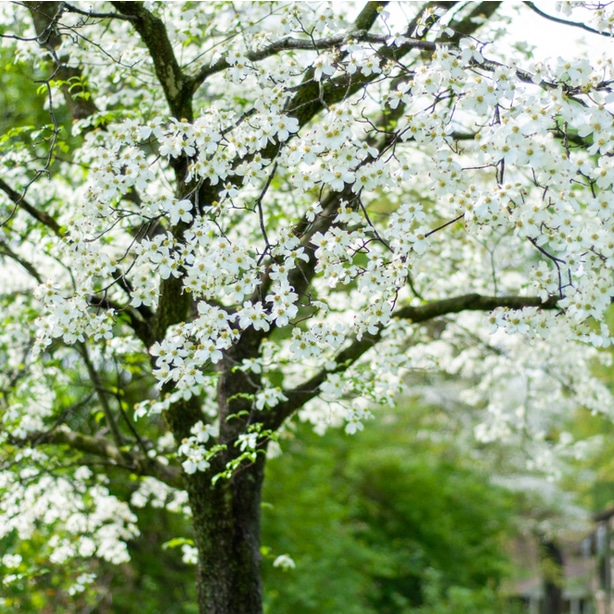
Site Preparation
After selecting a site with preferred light and soil conditions, it’s time to prep the area. Make sure the area is large enough for the dogwood to mature without interference. Proper air circulation prevents potential disease problems. Allowing trees and shrubs to achieve their natural size only enhances their beauty. Site preparation is relatively basic.
Now that you have the perfect site, it’s time to get to work.
Clear the area of any unwanted weed or grass growth. Unwanted growth in the area will rob your tree of its much-needed moisture. It also promotes problems with diseases and pests.
If you use a weed killer, wait at least a week for the growth to die. Once dead, remove it from the site by either raking it away or pulling it from the ground.
Soil Conditions
Regardless of whether you’re planting a dogwood tree or shrub, soil conditions are highly important. Plants require acidic soil for healthy growth. They won’t thrive in alkaline conditions lacking organic nutrients. Although many varieties prefer soil that drains well, some types can handle soggy conditions and even grow along the banks of a water source.
If needed, amend the planting site’s soil with organic matter before planting.
Spread 6 to 8 inches of well-rotted manure or compost over the planting site. Work it into the soil to a depth of about a foot.
In spring, you can add to your soil’s organic makeup. Spread several inches of organic material over the planting site and water into the soil.
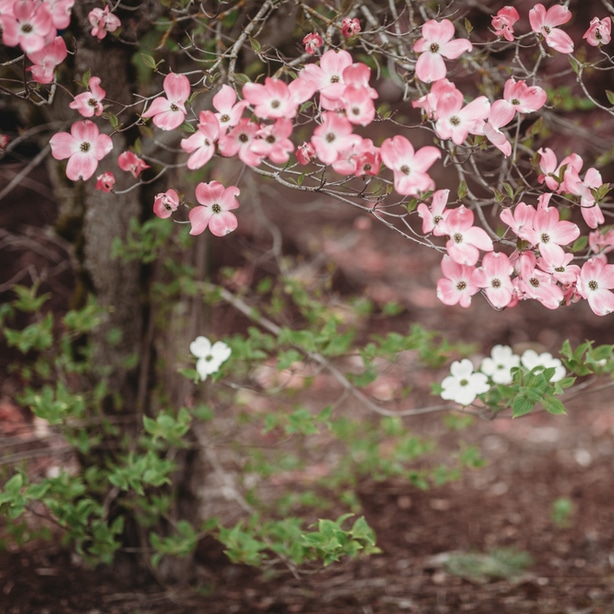
Amount of Sun
Another important reason to know the requirements of your particular variety is so you can give it the light conditions where it thrives. Many dogwood trees and shrubs tolerate growing in full sun to partial shade. However, some can’t take the hot conditions and prefer a partially shady site. Where you live and your climate conditions also play an important part.
If you live in a location that is hot and dry in the summer, then a partially shady location is probably best. They are thirsty plants and require frequent water. If you plant in a full sun site, be prepared to water more frequently.
Additionally, check what your particular variety prefers. Certain species, like dwarf cornels, only thrive in partial sun. They won’t grow well planted in full sun.
However, plants, like kousa, grow well planted in a full sun site when provided enough water.
Amount of Water
All types of dogwoods are thirsty plants. Regardless of whether planted in full sun or partial shade, they require water. Plants have high water requirements from the time their root ball is set into the ground through maturity. Your life will be easier if your dogwood is planted closer to a source of water.
Water well when first planted. Make sure to saturate the root ball thoroughly. It can take three to four months for the root system to establish itself in the new planting site. Therefore, you may need to water three to four times weekly, especially if your conditions are hot and dry.
When dealing with established dogwood plants, continue watering several times weekly. This is especially important during the summer when outdoor conditions in some locations are especially hot.
Although they have shallow roots close to ground level, it’s important to water deeply. Make sure you saturate the roots with each watering. Watering to a depth of 3 feet is sufficient.
You can tell if your tree isn’t getting enough moisture by checking the leaves. If the leaves change to a lighter color and become brittle, then it means you need to water more.
On the other hand, if the leaves change to a grayish color and droop, less water is required.
Adding several inches of organic mulch over the planting site helps the soil retain moisture. Just be sure to keep it pulled several inches away from the trunk.
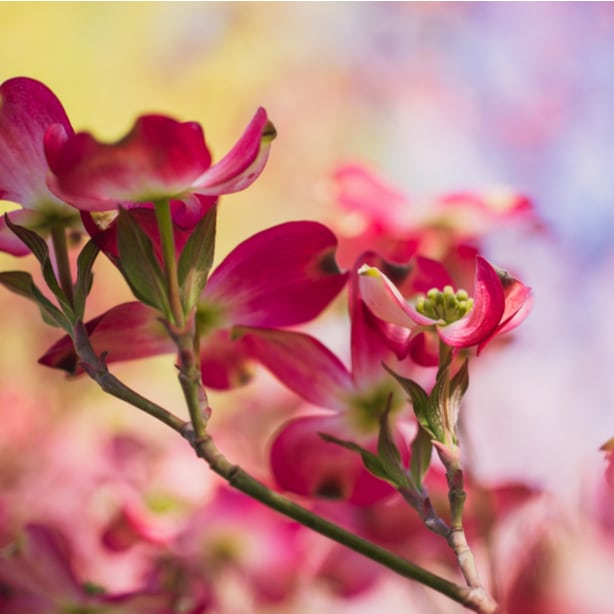
Fertilization
As with many things in life, too much of a good thing isn’t that good. This is true when it comes to fertilizing. Many professionals suggest holding off fertilizing until the second season of growth. Applying too much fertilizer to young trees can end up burning it or even killing it.
When you are trying to determine what kind of fertilizer to use, it’s best to get a soil test. This lets you know exactly what nutrients are missing and how much is needed.
If you will be feeding your dogwood without a soil test, use a general-purpose blend for acid-loving trees. Apply the product in springtime following package directions on amounts.
When applying, spread the fertilizer under the canopy. To prevent burning, don’t spread the product directly around the tree’s trunk. Spread it into the top surface of soil. Make sure to water the fertilizer so that it soaks into the soil.
Pruning
Dogwoods aren’t needy when it comes to pruning. They naturally develop a rounded form that requires little trimming. The only time you’ll need to pull out the pruning tools is to do light shaping or to improve the tree’s vigor. It’s best to do any serious pruning during fall or winter.
However, if branches are broken or happen to be in the way, you can prune it off anytime throughout the year.
Always use clean pruning tools when making your cuts. The last thing you want to do is transfer an unwanted disease to this beauty of a plant.
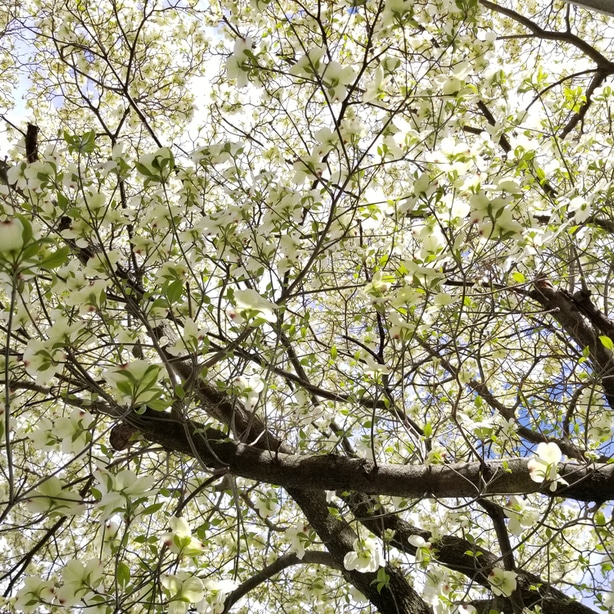
Disease Problems
The biggest threat to plants is dogwood anthracnose. Anthracnose is a fungal disease showing up through leaf spots and the dieback of twigs. You can prevent the problem by making sure the plant gets good circulation of air. Additionally, make sure you water properly, especially during hot and dry summers.
If you notice the problem on your tree, prune off affected areas. Make sure to use clean pruning tool blades, so you don’t transfer another disease to the tree.
Sterilizing your pruning tools is as easy as wiping the blades off with alcohol.
Design Ideas
Whether a tree, shrub, or groundcover, dogwoods add beauty to the landscape throughout all the seasons. Their canopies filled with cheery spring flowers bring a delightful appeal to any area. Even their brightly colored drupes bring colorful interest to the area. The fall foliage adds brilliant color to an otherwise cold fall landscape heading into winter.
Because birds are attracted to tree’s drupes, dogwoods are great additions to wildlife gardens. Butterflies love the blooms, making plants useful additions to pollinator gardens.
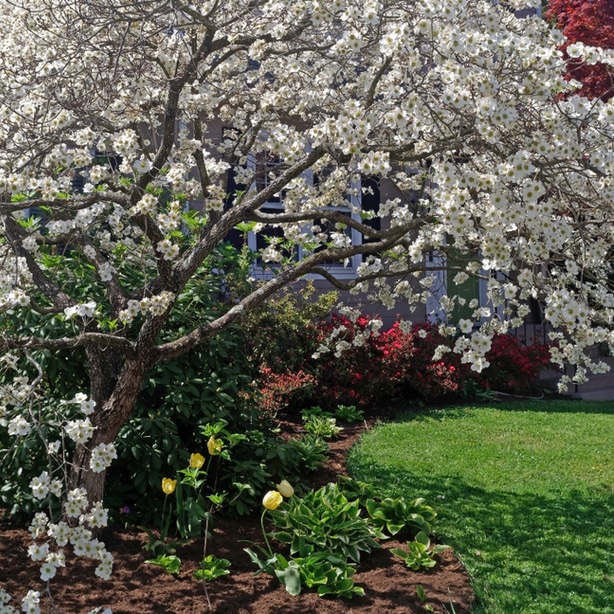
Native to woodland areas, adding one to your woodland garden brings pops of non-stop color to the area. Plant them at the woodland’s edge so you can enjoy the fabulous colors season after season. They also are good additions to native gardens.
Because of their stunning displays of color, dogwoods make fabulous specimens or accent plants. They certainly won’t be ignored. Whether used in the front or backyard, be sure to plant them where you’ll be able to relish the fabulousness.
Smaller varieties grow well planted under the canopy of taller shade trees. Since many grow as understory trees in their natural environment, a spot under a very tall tree is perfect. Just give them room to grow and spread out naturally. Just be sure the taller tree likes the same growing conditions.
If the dogwood tolerates wet conditions, you can easily plant them along the edge of a pond or water feature. They’ll be quite happy growing in the consistently moist conditions.
They also work well used in borders, mixed beds planted among other evergreens or as a hedge. Situating them by a porch or deck areas allows you to enjoy the tree’s beauty while you’re enjoying your outdoor space. Larger types even make good shade trees.
There’s almost no wrong way to utilize a dogwood tree in your landscape. Wherever you decide to call their place home, they’re sure to bring their extraordinary beauty for years to come.
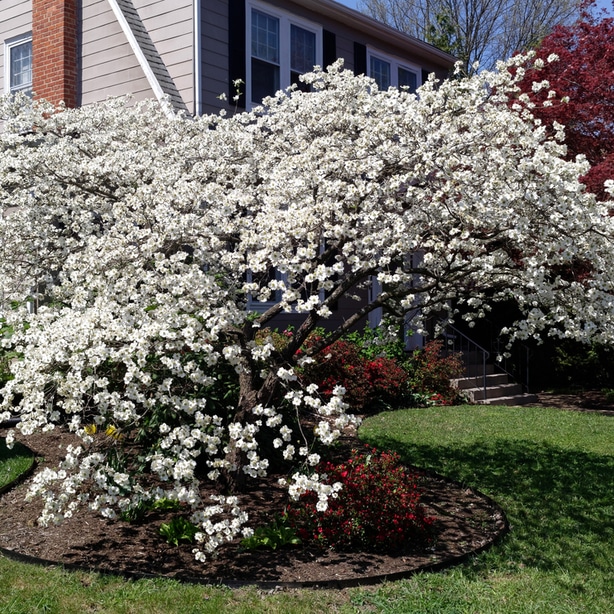
Companion Plants
When selecting companion plants to grow, it’s important to select those thriving in the same conditions. Make sure they grow well in the same soil, light, and moisture. You don’t want to plant something that prefers alkaline soil when your tree thrives in acidic soil. Similarly, don’t plant something preferring dryness when your tree thrives in moisture.
Ground Covers
Some good groundcovers that thrive with them include:
- Periwinkle (Vinca minor) hardy in USDA zones 4 to 9.
- Creeping Sedum (Sedum spp.) hardy in USDA zones 3 to 9.
- Mondo Grass (Ophiopogon japonicus) hardy in USDA zones 7 to 10.
- Bugleweed (Ajuga reptens) hardy in USDA zones 4 to 9.
Spring-Blooming Perennials
Good spring-blooming companions include:
- Astilbe (Astilbe x arendsii) hardy in USDA zones 4 to 8.
- Cranesbill Geranium (Geranium maculatum) hardy in USDA zones 4 to 8.
- Brunnera (Brunnera spp.) hardy in USDA zones 3 to 8.
- Helleborus (Helleborus spp.) hardy in USDA zones 6 to 9.
Summer-Blooming Perennials
Good companion perennials blooming in summer include:
- Hosta (Hosta spp.) hardy in USDA zones 2 to 10.
- Day Lilies (Hemerocallis spp.) hardy in USDA zones 3 to 10.
- Coral Bells (Heuchera spp.) hardy in USDA zones 4 to 9)
- Bearded Iris (Iris germanica) hardy in USDA zones 4 to 9.
Shrubs
Several shrubs that grow well as companions include:
- Bleeding Heart (Dicentra spectabilis) hardy in USDA zones 3 to 9.
- Gardenia (Gardenia spp.) hardy in USDA zones 8 to 11.
- Azalea (Rhododendron spp.) hardy in USDA zones 6 to 9.
- Heath (Erica x darlyensis) hardy in USDA zones 5 to 8.

